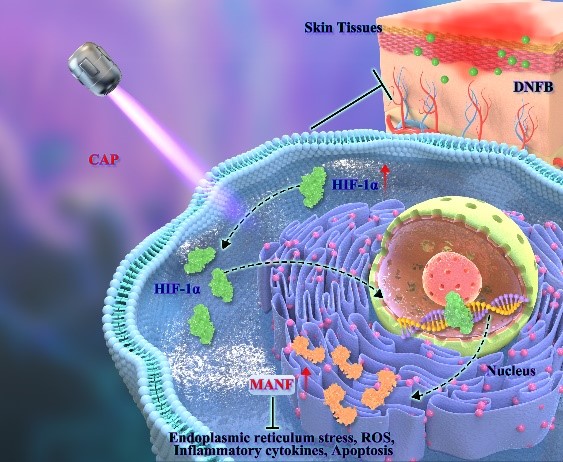
Recently, a research group led by Prof. NI Guohua from Hefei Institutes of Physical Science (HFIPS) of the Chinese Academy of Sciences (CAS), collaborated with Prof. Wang Dong from Anhui Medical University, challenged a new method, cold atmospheric plasma (CAP) to treat Atopic Dermatitis (AD), a chronic inflammatory skin disease, and was impressed by the effect.
Reported in the journal of Frontiers in Immunology, the research demonstrated CAP as a promising clinical application for the treatment of AD.
AD is a chronic inflammatory skin disease with a lifetime prevalence of up to 20%, which clinical manifestations were local skin erythema, papules, papules, severe itching, etc. The main clinical treatment of AD was topical hormonal drug used. Although they have good curative effect, their side effects are also obvious. So, it is urgent to find an effective and safe method to treat AD.
In this research, the group used a self-developed plasma device to produce CAP, and treated AD mice with CAP.
The results showed that CAP could inhibit the DNFB-induced skin inflammation. Skin erythema and papules were significantly reduced, abnormal superficial skin thickening was improved, and inflammatory factors were restored.
They also clarified the mechanism in this paper. CAP promoted the expression of hypoxia-inducible factor-1 (HIF-1), which was interacted with the promoter region of the midbrain astrocyte-derived neurotrophic factor (MANF) gene to enhances the transcriptional expression of MANF.
MANF has been proved play a protectory effect in the inflammation via bind to the promotor region of NF-κB pathway.
The group proved that CAP-induced HIF-1 up-regulation could promote MANF expression to inhibit AD.
This research work has been funded and supported by the National Natural Science Foundation of China and the National Key R&D Program.

Mechanism of CAP in the treatment of AD (Image by SUN Tao)